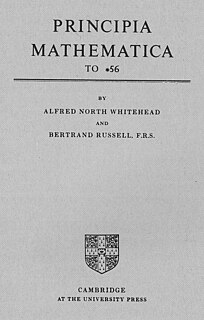
In mathematics, the axiom of choice, or AC, is an axiom of set theory equivalent to the statement that the Cartesian product of a collection of non-empty sets is non-empty. Informally put, the axiom of choice says that given any collection of bins, each containing at least one object, it is possible to make a selection of exactly one object from each bin, even if the collection is infinite. Formally, it states that for every indexed family of nonempty sets there exists an indexed family of elements such that for every . The axiom of choice was formulated in 1904 by Ernst Zermelo in order to formalize his proof of the well-ordering theorem.

The Principia Mathematica is a three-volume work on the foundations of mathematics written by Alfred North Whitehead and Bertrand Russell and published in 1910, 1912, and 1913. In 1925–27, it appeared in a second edition with an important Introduction to the Second Edition, an Appendix A that replaced ✸9 and all-new Appendix B and Appendix C. PM is not to be confused with Russell's 1903 The Principles of Mathematics. PM was originally conceived as a sequel volume to Russell's 1903 Principles, but as PM states, this became an unworkable suggestion for practical and philosophical reasons: "The present work was originally intended by us to be comprised in a second volume of Principles of Mathematics... But as we advanced, it became increasingly evident that the subject is a very much larger one than we had supposed; moreover on many fundamental questions which had been left obscure and doubtful in the former work, we have now arrived at what we believe to be satisfactory solutions."
In computability theory, Rice's theorem states that all non-trivial, semantic properties of programs are undecidable. A semantic property is one about the program's behavior, unlike a syntactic property. A property is non-trivial if it is neither true for every computable function, nor false for every computable function.
In mathematical logic and computer science, the general recursive functions or μ-recursive functions are a class of partial functions from natural numbers to natural numbers that are "computable" in an intuitive sense. In computability theory, it is shown that the μ-recursive functions are precisely the functions that can be computed by Turing machines. The μ-recursive functions are closely related to primitive recursive functions, and their inductive definition (below) builds upon that of the primitive recursive functions. However, not every μ-recursive function is a primitive recursive function—the most famous example is the Ackermann function.
Computability theory, also known as recursion theory, is a branch of mathematical logic, of computer science, and of the theory of computation that originated in the 1930s with the study of computable functions and Turing degrees. The field has since expanded to include the study of generalized computability and definability. In these areas, recursion theory overlaps with proof theory and effective descriptive set theory.

In mathematical logic, the arithmetical hierarchy, arithmetic hierarchy or Kleene–Mostowski hierarchy classifies certain sets based on the complexity of formulas that define them. Any set that receives a classification is called arithmetical.
In computability theory, traditionally called recursion theory, a set S of natural numbers is called recursively enumerable, computably enumerable, semidecidable, provable or Turing-recognizable if:
In computability theory, the μ operator, minimization operator, or unbounded search operator searches for the least natural number with a given property. Adding the μ-operator to the five primitive recursive operators makes it possible to define all computable functions.
Computable functions are the basic objects of study in computability theory. Computable functions are the formalized analogue of the intuitive notion of algorithm, in the sense that a function is computable if there exists an algorithm that can do the job of the function, i.e. given an input of the function domain it can return the corresponding output. Computable functions are used to discuss computability without referring to any concrete model of computation such as Turing machines or register machines. Any definition, however, must make reference to some specific model of computation but all valid definitions yield the same class of functions. Particular models of computability that give rise to the set of computable functions are the Turing-computable functions and the μ-recursive functions.
In computability theory, a machine that always halts, also called a decider or a total Turing machine, is a Turing machine that eventually halts for every input.
In computability theory the smn theorem, is a basic result about programming languages. It was first proved by Stephen Cole Kleene (1943). The name "smn" comes from the occurrence of a s with subscript n and superscript m in the original formulation of the theorem.
In logic, finite model theory, and computability theory, Trakhtenbrot's theorem states that the problem of validity in first-order logic on the class of all finite models is undecidable. In fact, the class of valid sentences over finite models is not recursively enumerable.
In computability theory, the T predicate, first studied by mathematician Stephen Cole Kleene, is a particular set of triples of natural numbers that is used to represent computable functions within formal theories of arithmetic. Informally, the T predicate tells whether a particular computer program will halt when run with a particular input, and the corresponding U function is used to obtain the results of the computation if the program does halt. As with the smn theorem, the original notation used by Kleene has become standard terminology for the concept.
Bar recursion is a generalized form of recursion developed by C. Spector in his 1962 paper. It is related to bar induction in the same fashion that primitive recursion is related to ordinary induction, or transfinite recursion is related to transfinite induction.
Transfer function filter utilizes the transfer function and the Convolution theorem to produce a filter. In this article, an example of such a filter using finite impulse response is discussed and an application of the filter into real world data is shown.



